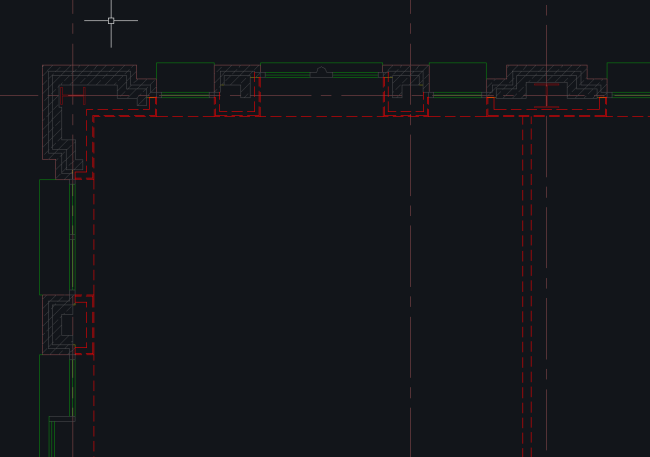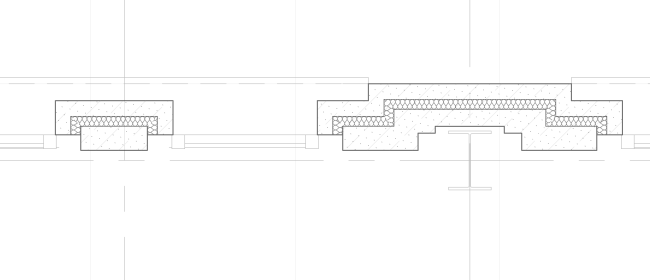Turn on suggestions
Auto-suggest helps you quickly narrow down your search results by suggesting possible matches as you type.
Showing results for
Turn on suggestions
Auto-suggest helps you quickly narrow down your search results by suggesting possible matches as you type.
Showing results for
- Graphisoft Community (INT)
- :
- Forum
- :
- Modeling
- :
- workflow-windows in walls with one skin removed
Options
- Subscribe to RSS Feed
- Mark Topic as New
- Mark Topic as Read
- Pin this post for me
- Bookmark
- Subscribe to Topic
- Mute
- Printer Friendly Page
Modeling
About Archicad's design tools, element connections, modeling concepts, etc.
workflow-windows in walls with one skin removed
Options
- Mark as New
- Bookmark
- Subscribe
- Mute
- Subscribe to RSS Feed
- Permalink
- Report Inappropriate Content
2014-12-22
11:09 PM
- last edited on
2023-05-24
08:54 AM
by
Rubia Torres
2014-12-22
11:09 PM

The dashed red lines indicate the interior skin to be removed.
Here's where I'm at in ArchiCAD:

The light lines are a trace reference of my CAD file. In an initial approach I modeled the removed skin as a seperate wall right against the portion which is to remain, but inserting a window then becomes a problem (can't insert a window through two walls).
What do people do in this situation? This question also has two scenarios:
- The first is when you are just modeling the existing conditions, and don't yet know what is being demo'd.
- The second is like my situation - going into the project already knowing that the interior skin will be demo'd.
5 REPLIES 5
Options
- Mark as New
- Bookmark
- Subscribe
- Mute
- Subscribe to RSS Feed
- Permalink
- Report Inappropriate Content
2014-12-23 03:11 AM
2014-12-23
03:11 AM
The image above from ArchiCAD does not show the removed inner skin. To make matters more complicated a new inner skin is being proposed.
Anonymous
Not applicable
Options
- Mark as New
- Bookmark
- Subscribe
- Mute
- Subscribe to RSS Feed
- Permalink
- Report Inappropriate Content
2014-12-23 03:24 AM
2014-12-23
03:24 AM
You could put empty openings in the additional / new skins. It would mean updating them if/when actual windows move, but could be manageable.
Options
- Mark as New
- Bookmark
- Subscribe
- Mute
- Subscribe to RSS Feed
- Permalink
- Report Inappropriate Content
2014-12-23 03:47 AM
2014-12-23
03:47 AM
Thank you Stuart. This is an interesting approach as it also seems to give me the opportunity to "demo" the interior window sill and create a new one for construction. I'll have to dig into this a bit more......
Anonymous
Not applicable
Options
- Mark as New
- Bookmark
- Subscribe
- Mute
- Subscribe to RSS Feed
- Permalink
- Report Inappropriate Content
2014-12-27 04:33 AM
2014-12-27
04:33 AM
arg617,
I do it as Stuart suggested, and maybe a little 'extended' from that:
My template has separate layers for the structural wall components, the exterior finish, and the interior finish. All those layers have differing intersection priority numbers so they won't 'heal' to each other.
I have yet another layer just for the fenestration assemblies, again with it's own priority number. I use pieces of wall drawn on this layer to 'hold' my door and window objects. I size the pieces of wall to fit the door or window outer frame sizes. I set the fenestration objects' markers and ID's as required to be 'read' by my schedule schemes (also preconfigured in my template file).
So, what this yields is full flexibility in managing all the various assemblies. I'll draw the structural walls and put the holes in them using Empty Opening objects, with the markers turned off and the ID's set to be ignored by the schedule schemes (In my case, an ID of 'X' gets ignored by the schedule schemes).
For the exterior and interior finishes, I (mostly) use the wall tool. I'll either use the Empty Opening object to cut the holes, just like in the structural walls, or model the wrap of the materials any way I like to do reveals, different head/jamb/sill materials meeting at an opening, or whatever the architectural design requires.
If you want, you can even set up analog layers for 'existing' and 'demolition' elements if you like... Some people use the Renovation Filters for that, though.
Additionally, on remodels like your project, I'll construct a model of the existing building and save it to a unique file name (as a record). I copy that file to a 'demo' version, and again to a third file that represents the 'remodeled' version. I'll have the demo and remodel files open simultaneously, and will modify the demo file as I work on the remodel file. I place views of the demo file on my demo layouts, and views of the remodel file to the normal architectural layouts ('A' sheets).
Hope that helps. You can actually extend this methodology to other building elements, too; like floor and roof assemblies (which I do).
I still use Composites, but only for things that I know will have the same extents, always. For instance, I have composites for stud wall framing with a layer of plywood or OSB structural paneling. I don't use composites to model entire wall assemblies because in the real world, that is often not what happens; gypsum board is always installed with a little bit of reveal from the floor at the sill plates, and sometimes won't go to the top plate (because it may stop at soffit framing, a change of finishes, or such). Same goes for exterior wall finishes; a lot of times plaster or stone will cross the line of the wall sill / foundation junction, or go past the wall's top plate. My methodology allows for that. Since I use live wall sections for detailing, the extra time spent building a super-accurate model saves time when I detail; the live wall section doesn't require any patching or fixing... It just needs flashings and membranes applied with 2D line work, dimensioning, and annotation.
It's 'a' way... See if it works for you.
Best wishes,
Dave Sanders
I do it as Stuart suggested, and maybe a little 'extended' from that:
My template has separate layers for the structural wall components, the exterior finish, and the interior finish. All those layers have differing intersection priority numbers so they won't 'heal' to each other.
I have yet another layer just for the fenestration assemblies, again with it's own priority number. I use pieces of wall drawn on this layer to 'hold' my door and window objects. I size the pieces of wall to fit the door or window outer frame sizes. I set the fenestration objects' markers and ID's as required to be 'read' by my schedule schemes (also preconfigured in my template file).
So, what this yields is full flexibility in managing all the various assemblies. I'll draw the structural walls and put the holes in them using Empty Opening objects, with the markers turned off and the ID's set to be ignored by the schedule schemes (In my case, an ID of 'X' gets ignored by the schedule schemes).
For the exterior and interior finishes, I (mostly) use the wall tool. I'll either use the Empty Opening object to cut the holes, just like in the structural walls, or model the wrap of the materials any way I like to do reveals, different head/jamb/sill materials meeting at an opening, or whatever the architectural design requires.
If you want, you can even set up analog layers for 'existing' and 'demolition' elements if you like... Some people use the Renovation Filters for that, though.
Additionally, on remodels like your project, I'll construct a model of the existing building and save it to a unique file name (as a record). I copy that file to a 'demo' version, and again to a third file that represents the 'remodeled' version. I'll have the demo and remodel files open simultaneously, and will modify the demo file as I work on the remodel file. I place views of the demo file on my demo layouts, and views of the remodel file to the normal architectural layouts ('A' sheets).
Hope that helps. You can actually extend this methodology to other building elements, too; like floor and roof assemblies (which I do).
I still use Composites, but only for things that I know will have the same extents, always. For instance, I have composites for stud wall framing with a layer of plywood or OSB structural paneling. I don't use composites to model entire wall assemblies because in the real world, that is often not what happens; gypsum board is always installed with a little bit of reveal from the floor at the sill plates, and sometimes won't go to the top plate (because it may stop at soffit framing, a change of finishes, or such). Same goes for exterior wall finishes; a lot of times plaster or stone will cross the line of the wall sill / foundation junction, or go past the wall's top plate. My methodology allows for that. Since I use live wall sections for detailing, the extra time spent building a super-accurate model saves time when I detail; the live wall section doesn't require any patching or fixing... It just needs flashings and membranes applied with 2D line work, dimensioning, and annotation.
It's 'a' way... See if it works for you.
Best wishes,
Dave Sanders
Options
- Mark as New
- Bookmark
- Subscribe
- Mute
- Subscribe to RSS Feed
- Permalink
- Report Inappropriate Content
2015-01-23 08:11 PM
2015-01-23
08:11 PM
Wow - thank you for the detailed response Dave. I haven't even begun to dig into layers yet. In fact, I've really fallen behind in learning the software. I didn't realize you can set priorities with layers.
Why do you use separate models for Existing/Demo?Remodel rather than just use the renovation filter?
I'd love to see some examples of these workflows.......
Why do you use separate models for Existing/Demo?Remodel rather than just use the renovation filter?
I'd love to see some examples of these workflows.......
Suggested content
- Placing a window/door between split walls? in Modeling
- Survey point in 29 in Project data & BIM
- Column/Wall Line not visible when viewing individually in Modeling
- Creating an Organic Perforated Facade in PARAM-O — Is It Possible? in Modeling
- How to remove Door Handles from the outside of the door in Libraries & objects
